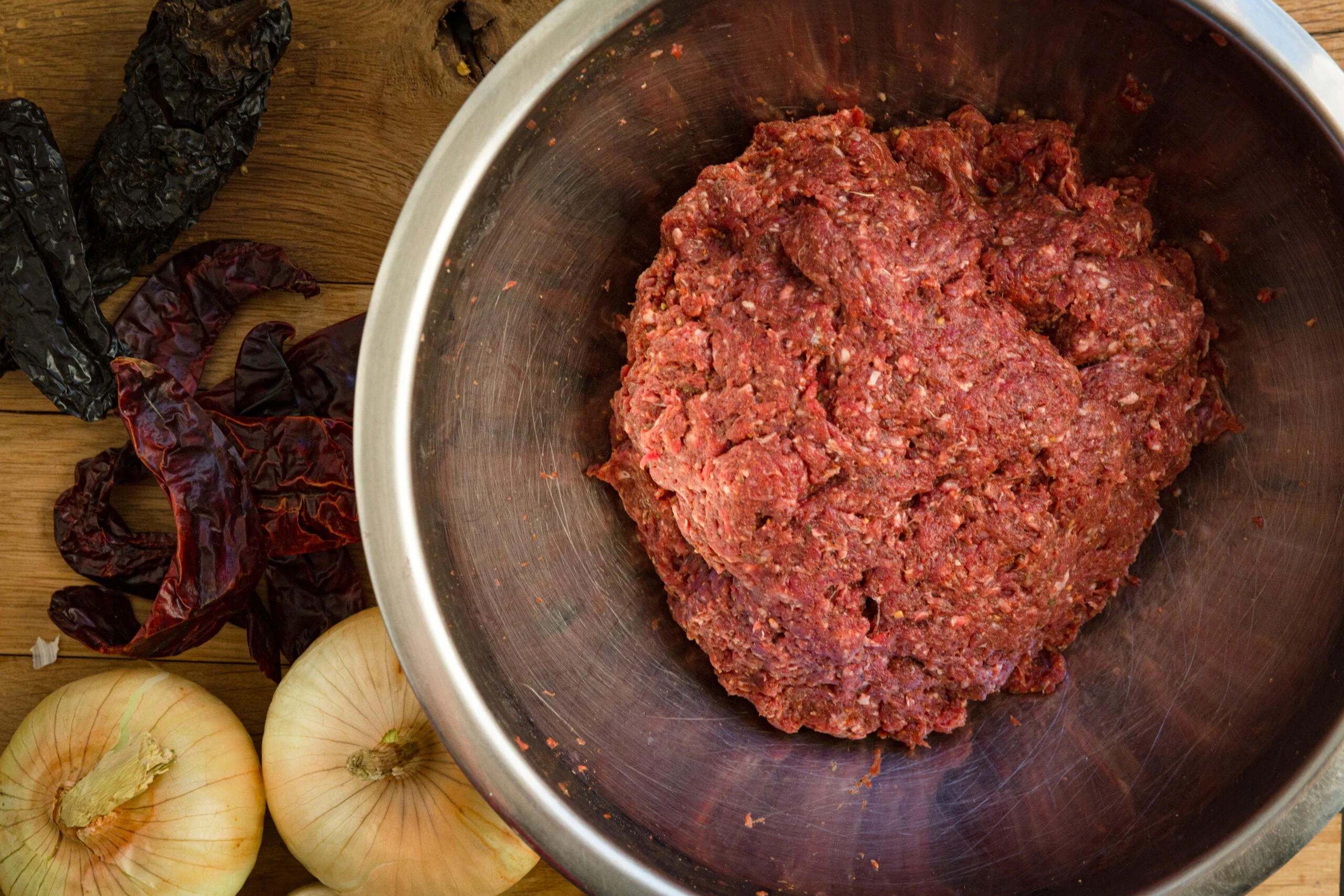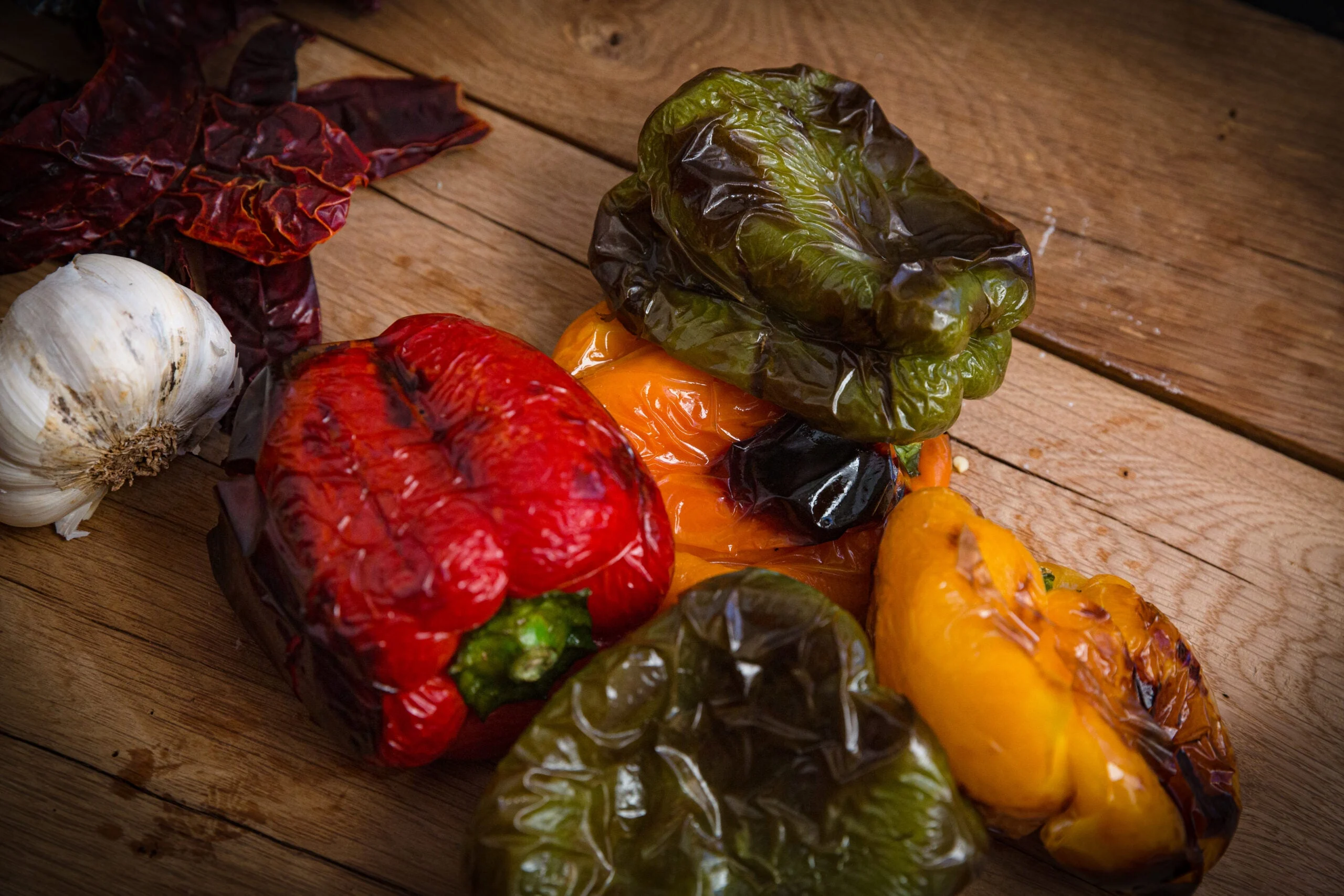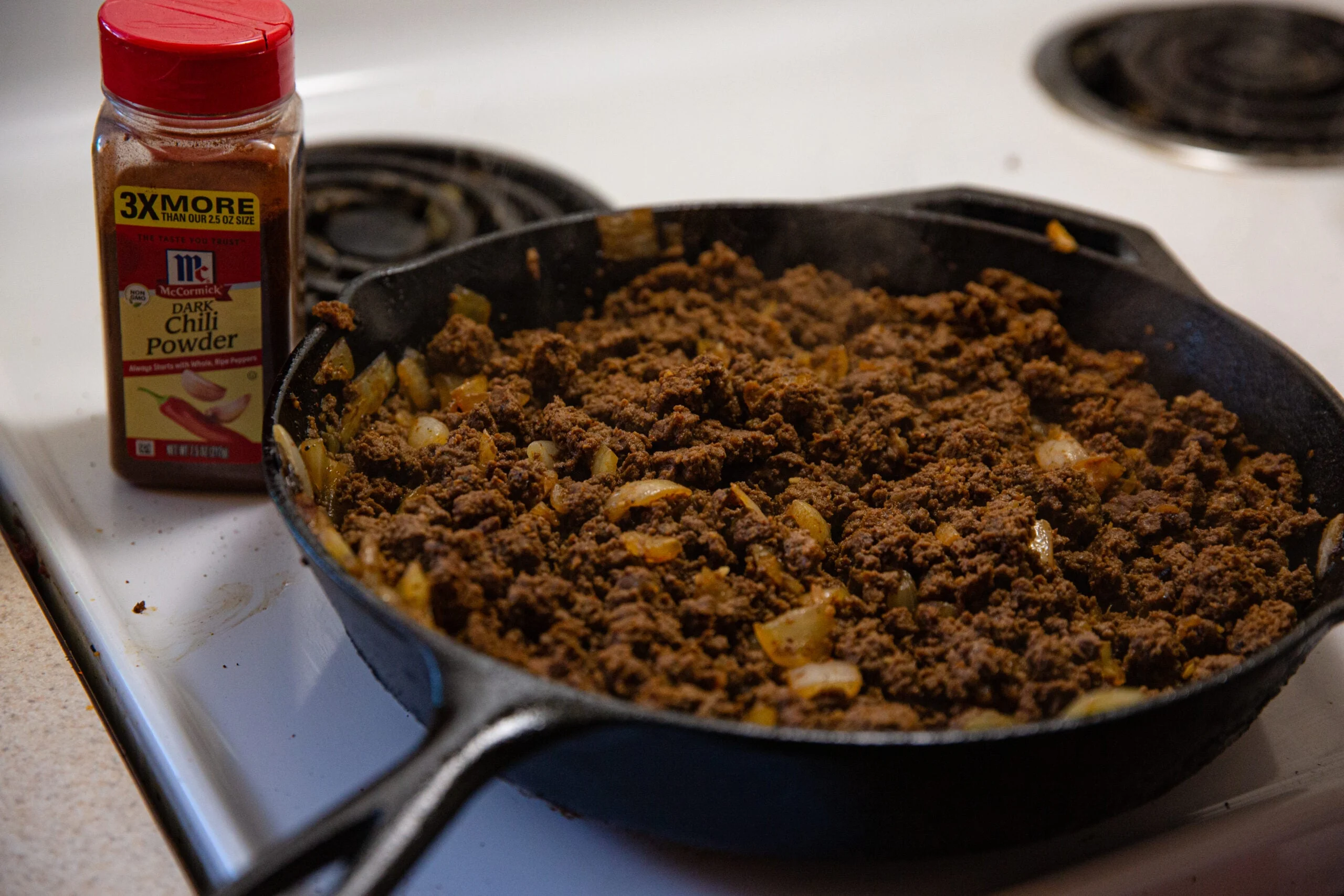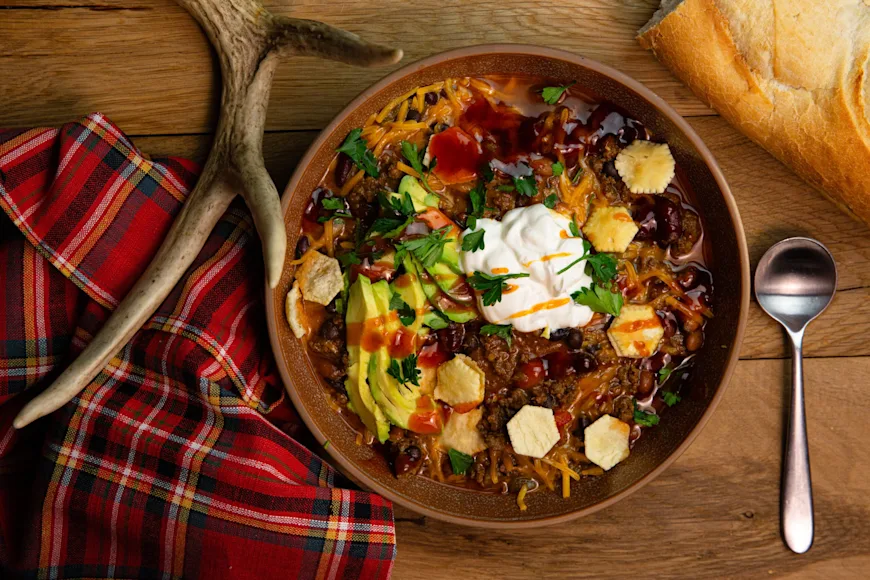How exactly do you make a better venison
chili recipe? No, it doesn’t start with reminding everyone that chili with beans is technically not “chili.” It comes from decades of refinement, from taking family secrets passed down and applying them to what you and your spouse and kids enjoy, all while utilizing one of the healthiest proteins on the planet: deer meat.
Every deer hunter
has got his or her “best venison chili recipe,” and while you may be hesitant to tweak anything, I can promise you will learn something here you may wish to try—regardless of how “award-winning” your current recipe is.

Dig in. Jack Hennessy
Table of Contents
5 Tips for How to Make Your Venison Chili Recipe Taste Better
Classic Venison Chili Recipe
Want a Venison Chili Recipe Without Beans?
FAQs
5 Tips for How to Make Your Venison Chili Recipe Taste Better
Consider incorporating some form of fat to get your ground meat
mix to 10% fat. Pure venison is incredible, but also super lean, so when cooked in chili, I feel it takes like eating wads of wet, shredded newspaper. For this reason, I like to incorporate 1 pound of ground pork shoulder per 2 pounds of venison.
1) Add Fat
When mixing the fat, treat it like making venison sausage
, which means only mix meat together when both meats are very, very cold. This assists with protein extraction so fat and proteins will bind together properly. Feel welcome to add a bit of cold dark Mexican beer during mixing to further assist with protein extraction.

When properly mixed your venison-and-pork-shoulder mix should be tacky, the same as if you were making sausage. Jack Hennessy
2) Roast Your Peppers
If you use bell peppers, consider roasting them until slightly charred then sweat (place in container and cover and put in fridge) to loosen skin, which you want to peel. Then you chop the peppers. Roasting and sweating and then peeling all makes for better flavor and texture. (If you like spice, consider using poblano pepper instead of bell peppers.)

Roasted, sweated, and peeled bell peppers make for better flavor and texture versus simply chopping and adding to your chili. Jack Hennessy
3) Use Stock—But Skip the “Bean Juice”
For a part of your liquids, consider adding some chicken or beef stock—or perhaps even some venison stock or broth, if you have some good stuff on hand. If using canned beans, you may wish to rinse the beans prior to adding to your chili. Beans by themselves are good, but you may wish to reduce the total addition of “bean juice,” which can detract from intended chili flavor.
4) How to Season Your Venison Chili Recipe
Always salt to taste
. This advice applies to any cooking. What it means: Because salt allows our tastebuds to experience more, salt itself makes food taste “not bland.” If your chili tastes bland, it could benefit for a bit more kosher salt. Do note: “salt to taste” doesn’t mean you should be able to taste the salt—as that is referred to as “salty”—but rather means you are adding just enough salt so you can taste as you are meant to taste, where your tastebuds are fully opened up and appreciating different flavor notes.
5) Go Wild With Toppings
Lastly, don’t forget to add. your favorite toppings to your venison chili recipe: sour cream, shredded cheese, oyster crackers, sliced avocado, perhaps finely minced cilantro. My personal favorite is a drizzle of BW3’s Mango Habanero, or even their Blazin’ sauce.
Classic Venison Chili Recipe
Ingredients
2 pounds ground venison
1 pound ground pork shoulder
1 1.75-ounce McCormick chili spice packet
1/4 cup cold dark Mexican beer
1 medium yellow onion, diced
4-5 poblano peppers (or mix of bell peppers)
1 15-ounce. can of black beans
2 15-ounce cans of pinto beans
1 15-ounce cans of kidney beans
1-1/2 cups Spicy V8 juice
1-1/2 cups of chicken stock
Additional chili powder, as necessary
Kosher salt and black pepper, divided use
Vegetable or sunflower cooking oil
Buffalo Wild Wings Mango Habanero sauce for drizzle (optional)
Sour cream, shredded cheese, oyster crackers, and sliced avocados garnish (optional)
Venison Chili Recipe Directions
Ahead of cooking, make sure your meats are very cold and mix together thoroughly with the McCormick spice packet and beer. Mix until tacky. Set aside in the fridge until ready to cook.
When ready to cook, preheat your oven to 400 degrees and place a medium skillet on a burner set to medium-high heat.
Rub all the peppers with cooking oil and dice your onion.
Open all of the bean cans and drain the liquids. Rinse the beans thoroughly in a colander under cold running water.
Place the oiled peppers in the oven once the oven reaches 400 degrees.
Add a thin layer of cooking oil to the skillet and add the diced onion. Dust with kosher salt and black pepper.
Once the onion has browned and is slightly soft, remove and set aside. In the same skillet, add a bit more cooking oil followed by your meat mixture. Continue to stir the meat as it browns.
After 10 minutes of roasting in the oven, check the peppers and rotate to sear the other side. Check again after 8 minutes. Remove once all of the peppers have sear marks, are very slightly charred, and the outer skin is loose.
Place the peppers in a large bowl and cover with aluminum foil or plastic wrap. Place the covered bowl in the refrigerator to sweat the peppers for a half hour.
Once the meat is thoroughly browned, add the onions back to the skillet along with a bit of chicken stock. Allow to simmer for a few minutes.
In a separate, large pot, add your rinsed beans, V8, and the rest of the chicken stock. Set the burner below to low.
Once the meat is fully cooked and has simmered, add it and the onions to the large pot with the beans. Stir thoroughly but be careful not to mush the beans.
Remove the peppers from the bowl after a half hour in the fridge, or once the outer skin is loose. Peel off skin and remove seeds and pulp. Dice the peppers and add to the large pot.
Stir the ingredients thoroughly and let simmer for at least 30 minutes before serving. Salt to taste as necessary and add any extra chili powder if you feel it needs it. Don’t forget to pile on your favorite toppings when dishing out. Makes 4-6 servings

Feel welcome to get liberal with your chili-powder seasoning. Jack Hennessy
Want a Venison Chili Recipe Without Beans?
History suggests the origin of chili, also knowns as “chili con carne,” dates back to the 1700s and was first served somewhere along the Mexico-Texas border. Some sources suggest it was created to serve as sustenance during cattle drives. Since chili peppers and onions were abundant, those ingredients were incorporated. Many people today—especially those from Texas—contest “authentic chili” is simply chiles, or a chili-pepper paste, combined with meat and perhaps a few others spices. No beans. No tomatoes.
How would you make this venison chili recipe if you wanted to give a try? For starters, you’d need far more meat than normal, as beans were incorporated into chili to stretch it. Same goes for tomatoes, to a certain extent. So take your normal chili recipe that contains beans and tomatoes, and substitute that volume with more venison.
How to Make a Chili Paste
For your chili paste, per 2- to 3-pound batch of chili, work with 8 ounces each of dried guajillo chiles, morita chiles, and chipotle peppers. (You can find these on Amazon if you can’t find at a local grocer.). Rehydrate the peppers, then add to a steel China cap strainer and press the peppers through the sieve to push out a paste. Rotate peppers as necessary in the strainer. You should get at least 1 cup of chili paste.
Next Steps for Making Venison Chili Without Beans
Next, you can work with either ground or cubed venison (approximately half-inch-by-half-inch pieces). Spice and sear venison. Remove. Seared a chopped onion, then add venison back to skillet or pot. Add some finely minced garlic. Add your chili paste, a half cup of beef stock or more as necessary, and a half cup of dark beer. Simmer until the venison is tender. Thicken with cornstarch, if necessary. To avoid drying out, add a mix of beef stock and dark beer as necessary.
FAQs
How do you make venison chili “less gamey”?
Venison tastes how venison is supposed to taste. Describing venison as “gamey” because it doesn’t taste like beef is an inaccurate use of the term. However, “gamey” flavors are possible if the animal wasn’t properly cared for from kill to freezer, or if the hunter shot a big buck toward the end of the rut.
But, to answer the question, here are some general tips: Grind fresh, if you can, and use top-tier primal cuts to do so such as roasts from the hindquarter. Avoid including fascia or silver skin in your grind. Even a pristine doe will provide adverse flavors if you bite into a bit of silver skin in your grind. Consider mixing 2:1 venison to ground pork shoulder. Lastly, you can always add more chili powder, as is it fairly difficult to over-spice your chili using chili powder.
Can you substitute venison for beef?
Yes, you can, and you absolutely should substitute venison for beef in your chili whenever possible. If doing a straight swap (so going from 100% beef to 100% venison), the only downside is the texture of your meat may taste like shredded newspaper. For this reason, it is a good idea to incorporate some ground pork into my venison chili.
What is the best meat for chili?
Any red meat will make for a great-tasting red chili. The flavor profile will vary based on the species you incorporate, meaning, yes, you can make a duck chili. It’ll just taste like duck chili. I do suggest whatever red meat or blend you choose, you want approximately 10% fat in the mix, as too lean of meat can produce mealy bites. So, when using venison, which is approximately 5% fat, I suggest incorporating ground pork shoulder, which is perhaps 20% fat, but when combined at a 2:1 ratio, it balances out to 10% of total mix. Or, you could grind up some bacon and include, as bacon is approximately 60% fat. (Because of its high fat content, you may only wish to use 5 ounces of ground bacon per 2 pounds of ground venison.)
How long can deer chili sit out?
Deer chili, like any other stew, soup—or any food for that matter—is susceptible to foodborne illness when its temperature falls within the range of 41-159 F, which is considered the “danger zone” where bacteria and other pathogens can grow over time. During my years working in professional kitchens, when we pulled soup from the stove, we were required to pour that soup into bus tubs with the soup never exceeding 2 inches for depth (so we had to use multiple bus tubs). We let those tubs cool at 36 F uncovered for a couple hours, as that is the goal: to get something hot to below 40 F within 2-3 hours for purpose of proper food safety.
All that said, professional-kitchen food-safety practices overcompensate for “worst possible scenario.” The truth is if you left your chili unheated for a few hours at room temp, there would be no harm in this. Still, you may wish to keep warm via a Crock Pot. Keep covered to not to dry out while warm, but when looking to store in a cool place, keep uncovered, as covered hot stuff in a cold environment will create condensation and, in turn, quickly grow bacteria and spoil the food.


